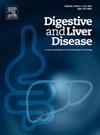Assessing Early HCC Recurrence After Liver Transplantation: The Predictive Value of 18F-FDG PET/CT and Microvascular invasion
IF 3.8
3区 医学
Q1 GASTROENTEROLOGY & HEPATOLOGY
引用次数: 0
Abstract
Background and Aims
Liver transplantation (LT) is the most effective treatment against hepatocellular carcinoma, but recurrence remains challenging. Traditional criteria based on tumor size, nodule number and AFP levels have limited success in predicting aggressiveness. 18F-FDG PET/CT has shown promise in identifying high-risk tumor features, including microvascular invasion (MVI), a key predictor of recurrence.
Methods
In this retrospective, single-center study, all consecutive patients who underwent LT for HCC between 2010 and 2019 were included. During pre-LT work-up all patients underwent 18F-FDG PET/CT and, following the LT, explant pathology was analyzed for MVI and other histological features. The primary endpoint was to identify predictors of early HCC recurrence (within 24 months after LT). Secondary endpoints included identifying predictors of high-risk histological features at explant, describing recurrence patterns, and assessing post-recurrence survival.
Results
The study included 143 patients (median age 59 years [IQR 54-64], 85% males, median MELD 10 [IQR 8-14], median AFP value 8.5 [IQR 4-39] ng/ml. Forty (28%) HCC resulted 18F-FDG PET/CT positive and 25 (17%) developed HCC recurrence post-LT (median post-LT follow-up 49 months [IQR 28.5-77]), with 12 (48%) experiencing early recurrence. MVI at explant was independently associated with early recurrence (HR: 7.20, 95% CI 1.82-28.45, p=0.005), while intra-hepatic 18F-FDG PET/CT positivity within six months before LT independently predicted MVI at explant (OR 3.90, 95% CI 1.30–11.71, p=0.01).
Conclusions
18F-FDG PET/CT is a valuable tool for pretransplant risk assessment, predicting MVI, and indirectly predicting early recurrence. Its incorporation into the selection criteria for LT may enhance patient stratification and post-transplant outcomes.
评估肝移植术后早期HCC复发:18F-FDG PET/CT和微血管侵袭的预测价值
背景和目的银移植(LT)是治疗肝细胞癌最有效的方法,但复发仍然具有挑战性。基于肿瘤大小、结节数量和AFP水平的传统标准在预测侵袭性方面成功有限。18F-FDG PET/CT在识别高风险肿瘤特征,包括微血管侵袭(MVI),这是复发的关键预测因子。方法在这项回顾性单中心研究中,纳入了2010年至2019年期间所有连续接受肝细胞癌肝移植的患者。在肝移植前的检查中,所有患者都进行了18F-FDG PET/CT检查,在肝移植后,对移植体病理进行了MVI和其他组织学特征的分析。主要终点是确定早期HCC复发的预测因素(肝移植后24个月内)。次要终点包括确定外植体高危组织学特征的预测因素,描述复发模式,评估复发后生存率。结果纳入143例患者,中位年龄59岁[IQR 54-64],男性85%,中位MELD 10 [IQR 8-14],中位AFP值8.5 [IQR 4-39] ng/ml。40例(28%)HCC结果为18F-FDG PET/CT阳性,25例(17%)HCC在肝移植后复发(肝移植后中位随访49个月[IQR 28.5-77]),其中12例(48%)早期复发。外植体MVI与早期复发独立相关(HR: 7.20, 95% CI 1.82-28.45, p=0.005),而肝内18F-FDG PET/CT阳性在肝移植前6个月内独立预测外植体MVI (OR: 3.90, 95% CI 1.30-11.71, p=0.01)。结论18f - fdg PET/CT是评估移植前风险、预测MVI、间接预测早期复发的重要工具。将其纳入肝移植的选择标准可以增强患者的分层和移植后的预后。
本文章由计算机程序翻译,如有差异,请以英文原文为准。
求助全文
约1分钟内获得全文
求助全文
来源期刊

Digestive and Liver Disease
医学-胃肠肝病学
CiteScore
6.10
自引率
2.20%
发文量
632
审稿时长
19 days
期刊介绍:
Digestive and Liver Disease is an international journal of Gastroenterology and Hepatology. It is the official journal of Italian Association for the Study of the Liver (AISF); Italian Association for the Study of the Pancreas (AISP); Italian Association for Digestive Endoscopy (SIED); Italian Association for Hospital Gastroenterologists and Digestive Endoscopists (AIGO); Italian Society of Gastroenterology (SIGE); Italian Society of Pediatric Gastroenterology and Hepatology (SIGENP) and Italian Group for the Study of Inflammatory Bowel Disease (IG-IBD).
Digestive and Liver Disease publishes papers on basic and clinical research in the field of gastroenterology and hepatology.
Contributions consist of:
Original Papers
Correspondence to the Editor
Editorials, Reviews and Special Articles
Progress Reports
Image of the Month
Congress Proceedings
Symposia and Mini-symposia.
 求助内容:
求助内容: 应助结果提醒方式:
应助结果提醒方式:


